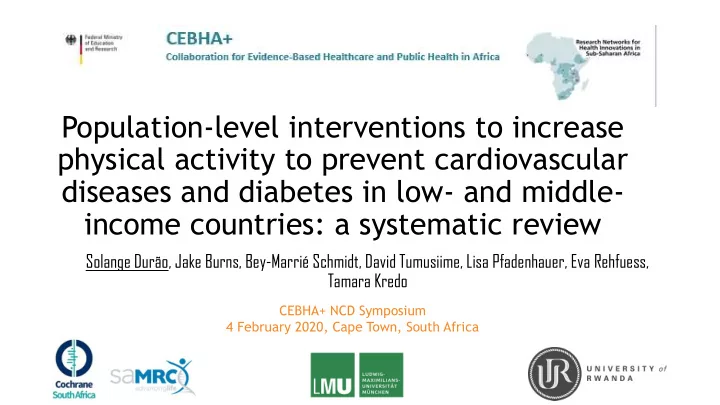

Population-level interventions to increase physical activity to prevent cardiovascular diseases and diabetes in low- and middle- income countries: a systematic review Solange Durão, Jake Burns, Bey-Marrié Schmidt, David Tumusiime, Lisa Pfadenhauer, Eva Rehfuess, Tamara Kredo CEBHA+ NCD Symposium 4 February 2020, Cape Town, South Africa
Disclosure of interests I have no actual or potential conflict of interests in relation to this presentation.
https://www.who.int/news-room/feature-stories/ten-threats-to-global-health-in-2019
Background Population-level interventions may be an effective way to increase physical activity, a modifiable risk factor for NCDs Existing reviews focus on Dietary risk factors (Heise 2016; von Philipsborn 2016; McLaren 2012; Lhachimi 2016; Pfinder 2016; Crocket 2011) Individual clinical condition, treatment and rehabilitation (Heath 2012; Klausen 2014; Geneen 2017) Community, workplace or school as specific settings (Baker 2011; Klausen 2014; Dobbins 2013) Effectiveness of population-level interventions to increase physical activity is unclear. To assess the effects of population-level interventions for increasing physical Objective activity with the primary or secondary aim to prevent CVD and diabetes in low- and middle-income countries (LMICs).
PICO – review scope Healthy populations of any age or gender, not diagnosed with CVDs or diabetes (in LMICs and Population HICs) 1. Technology and infrastructure interventions (e.g. green spaces/parks) Intervention 2. Policy and regulatory intervention (e.g. national school physical activity programme) no new intervention or existing interventions to promote physical activity Comparison (“business as usual”) Primary Secondary 1. Measures of population-level physical activity 8. Costs and cost-effectiveness 2. Anthropometry (e.g. BMI) 9. Satisfaction or dissatisfaction Outcomes 3. Blood pressure 10. Impacts on equity issues 4. CVD morbidity and mortality 11. Safety issues 5. Diabetes morbidity and mortality 12. Adverse effects
Inclusion criteria: Study designs • Randomized controlled trials (RCTs) • Cluster RCTs • Other rigorous non-randomized designs often used to evaluate population-level interventions • Controlled before-after (CBA) studies • Interrupted time-series (ITS) studies
Methods overview • Database searches: • MEDLINE; Embase; Web of Science ( Conference Proceedings Citation Index, Science Citation Index Expanded, Social Science Citation Index); ClinicalTrials.gov (inception February 2018) • Any language; published and unpublished • Duplicate screening and data extraction • Data synthesis using Harvest plots • Risk of Bias assessment: Cochrane ‘risk of bias’ tool adapted by EPOC • Certainty of evidence assessed with GRADE system
Results
Search results and study selection 13 CBA studies 2 ITS studies 1 cluster RCT
Included interventions Policies & regulations Technology & Infrastructure Green or other spaces (n Active transport Access to PA = 6) (n = 9) facilities (n = 1) • improvements to the • upgrade or construction of • Government scheme infrastructure by installing new parks, to increase access to sidewalks or cycle lanes • temporary closing of physical activity • extension of a motorway away streets to encourage facilities. from residential areas outside play and activities
Context & participants in included studies Population N Primary school children 5 Children living in selected 2 neighborhoods Adults 6 Pedestrians using selected interventions streets and people 3 visiting a park where the intervention was implemented No studies from LMICs identified
Outcomes reported in included studies Measures of physical activity: • Meeting PA guidelines • MVPA/ walking/ cycling (time/proportion)
Risk of bias assessment • Lack of randomization: Selection bias • Missing outcome data • Reported • Poor reporting
Effects of interventions 1 study/ outcome Intervention effects measure GRADE Certainty of evidence Outcomes
Green and other spaces • 6 studies • Intervention may slightly increase Physical Activity and reduce BMI
Active transport • 8 studies • It is uncertain whether active transport interventions increase Physical Activity or reduce BMI
Access to physical activity facilities • 1 study • Intervention may increase the use of Physical Activity facilities
Summary – what works? • 16 studies identified • No included studies in LMICs – applicability? • No CVD/Diabetes related endpoints reported • There is potential benefit for some interventions on physical activity and BMI, e.g. green spaces, but • variability and uncertainty regarding effectiveness • Little indication that interventions were harmful. • Complex interventions - Need to consider implementation context
References Baker, P.R., et al., Community wide interventions for increasing physical activity. Sao Paulo Medical Journal, 2011. 129 (6): p. 436-437. Heath, G.W., et al., Evidence-based intervention in physical activity: lessons from around the world. The lancet, 2012. 380 (9838): p. 272-281. Heise, T.L., et al., Taxation of sugar‐sweetened beverages for reducing their consumption and preventing obesity or other adverse health outcomes. The Cochrane Library, 2016. von Philipsborn, P., et al., Environmental interventions to reduce the consumption of sugar‐sweetened beverages and their effects on health. The Cochrane Library, 2016. McLaren, L., et al., Population-level interventions in government jurisdictions for dietary sodium reduction. status and date: New, published in, 2012(10). Lhachimi, S.K., et al., Taxation of the fat content of foods for reducing their consumption and preventing obesity or other adverse health outcomes. The Cochrane Library, 2016. Pfinder, M., et al., Taxation of unprocessed sugar or sugar‐added foods for reducing their consumption and preventing obesity or other adverse hea lth outcomes. The Cochrane Library, 2016. Crockett, R.A., et al., Nutritional labelling for promoting healthier food purchasing and consumption. The Cochrane Library, 2011. Klausen, S.H., et al., Interventions to increase physical activity for people with congenital heart disease (Protocol). Cochrane Database of Systematic Reviews, 2014. 3 : p. 1-11. Geneen, L.J., et al., Physical activity and exercise for chronic pain in adults: an overview of Cochrane Reviews. The Cochrane Library, 2017. Dobbins, M., et al., School‐based physical activity programs for promoting physical activity and fitness in children and adolescents aged 6 to 18. The Cochrane Library, 2013.
Recommend
More recommend